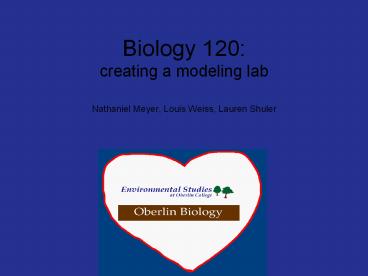Biology 120: creating a modeling lab - PowerPoint PPT Presentation
Title:
Biology 120: creating a modeling lab
Description:
How can we best create a lab exercise that provides enough information to give ... Give the lab to more biology students (without modeling background) ... – PowerPoint PPT presentation
Number of Views:63
Avg rating:3.0/5.0
Title: Biology 120: creating a modeling lab
1
Biology 120creating a modeling lab
- Nathaniel Meyer, Louis Weiss, Lauren Shuler
2
Background
- Target Audience
- Genetics, Evolution, Ecology Students and
teachers (Biology 120) - Teaching Objectives
- Provide an introduction to modeling and the
systems perspective - Reinforce Understanding of population dynamics
the - Lotka-Volterra predator-prey model
- r- k-selected species
- Build the associated model and draw conclusions
based on findings - Lotka-Volterra (predator-prey) oscillations
- Given a model and an interface, allow the
students to explore system dynamics by
systematically changing coefficients
3
Pedagogy
- Thought process
- How can we best create a lab exercise that
provides enough information to give students a
basis for exploring the concepts on their own? - Is building or exploring more effective at first?
- How do we avoid a recipe book lab?
- What questions do we ask to stimulate the
students? - Which concepts in the Biology 120 curriculum
would be most appropriate for a modeling lesson? - Which can be most effectively taught using
modeling? - Which is the best vehicle to teach modeling?
4
Structure
- Presented background on modeling including STELLA
software - Introduced the systems perspective i.e. stocks,
flows, and feedback - Guiding steps through the exponential (r-selected
species) model - Expand the exponential model to include a
carrying capacity (k-selected) - Provide an interface for the Lotka-Volterra model
5
r-selected Species
- Purpose of this model
- Introduce the students to the STELLA software and
modeling - Create a simple model of exponential growth
without a limiting resource - Help them understand what r means in
r-selected - Formulation Exponential Growth
- dN/dt RN
- NPert
6
Adding k (carrying capacity) to the model
- Purpose of this model
- Expand the students knowledge of STELLA by
creating a more complicated model - Help students understand what k means in
k-selected - Allow them to play with coefficients to see what
factors most heavily affect the system - Formulation Logistic Growth
- dN/dt rN(K-N) rNK CN2 (second order
loss, first order growth)
7
r- k-selected species Interface
8
Exploring Lotka-Volterra
- Purpose of this model
- Allow the students to explore predator-prey
population dynamics using a previously created
model - Systematically change coefficients to examine the
effect of each on system dynamics - Address feedback loops and explore their
implications in this model
Feedback Loop
(-)
Prey
Predator
9
(No Transcript)
10
(No Transcript)
11
Calibration
- We roughly calibrated the model to Hudson Bay
pelt data to find the correct coefficient values.
- We then reset the values and challenged the
students to calibrate the model as well.
Year Hares (x10) Lynx (x10)
0 300 40
2.7 470.2 60.1
5.4 700.2 90.8
8.1 770.4 350.2
10.8 360.3 590.4
13.5 200.6 410.7
16.2 180.1 190
18.9 210.4 130
21.6 220 80.3
24.3 250.4 90.1
27 270.1 70.4
29.7 400.3 80
32.4 570 120.3
35.1 760.6 190.5
37.8 520.3 450.7
40.5 190.5 510.1
43.2 110.2 290.7
45.9 70.6 150.8
48.6 140.6 90.7
51.3 160.2 100.1
54 240.7 80.6
12
Current Bio120 Student Reactions
- Fit the lab to the current Bio 120 lab structure
(break down into separate parts) - More explicit directions
- Cover more of the material discussed in lecture
- It would have been nice to see a simple
ecological model prior to constructing their own
(phytoplankton nutrients) - Allow for more hypothetical thinking maybe tell
us to conceptualize a food web model - We thought we could apply what we learned more
extensively (i.e. analogies)
13
Conclusions
- We need to spend more time working directly with
students who are unfamiliar with systems
modeling. - The balance between too much and too little
information is difficult to achieve. - This project and its integration into the biology
program is entirely feasible.
14
In the Future
- Meet with the three BIO 120 lab instructors and
John (during commencement, John?) to review our
exercise and discuss improvements. - Explore other possible biology topics to be used
in this exercise. - Give the lab to more biology students (without
modeling background).































